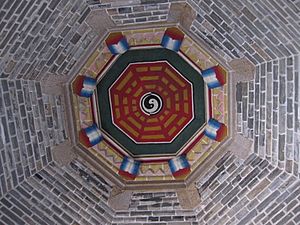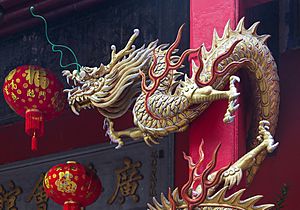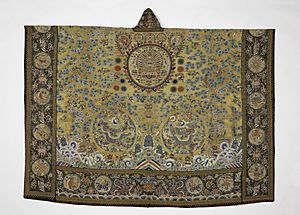Taoism facts for kids
Taoism or Daoism is a type of belief, or a way of thinking about life. It is at least 2,500 years old and it comes from China. Taoism is now said to be a philosophy. Tao (or Dao, 道) is the name of the force or the "Way" that Taoists believe makes everything in the world. Taoists think that words cannot be used to correctly describe Tao.
In Taoism, the Tao is the source of everything and the ultimate principle underlying reality. Taoism teaches about the various disciplines for achieving perfection through self-cultivation. This can be done through the use of Taoist techniques and by becoming one with the unplanned rhythms of the all, called "the way" or "Tao". Taoist ethics vary depending on the particular school, but in general tend to emphasize wu wei (action without intention), naturalness, simplicity, spontaneity and the Three Treasures: 慈, compassion, 儉, frugality and 不敢爲天下先, humility.
The very first line of the Dào Dé Jīng (道德经), the most important text in Taoism, says "the Way that can be explained in words is not the true Way." There are many other sacred writings by the teachers of Taoism.
Instead of spending a lot of time trying to explain what the Tao is, Taoists focus on living a simple and balanced life in harmony with nature. This is one of the most important principles in Taoism. Taoists also believe that conflict is not good and that if you have a problem with something, it is better to find a way around it.
The roots of Taoism go back at least to the 4th century BCE.
Contents
History
Taoism first showed up in writing in China about 2500 years ago. People do not always write about their religions at first, so this religion may be much older.
The history of Taoism stretches throughout Chinese history. It originated in prehistoric China and has had a powerful influence on Chinese culture throughout the ages.
Laozi is traditionally regarded as the founder of Taoist religion and is closely associated in this context with "original" Taoism. Whether he actually existed is disputed.The work attributed to him – the Daodejing – is dated between the 8th and 3rd century BC. Moreover, the Yellow Emperor, Huangdi (2697–2597 BCE) is often associated with the origin of the Tao.
Some elements of Taoism may be traced to prehistoric folk religions in China that later grew into a Taoist tradition. In particular, many Taoist practices drew from the Warring-States-era phenomena of the Wu (shaman) (connected to the "shamanism" of Southern China) and the [[Fangshi], even though later Taoists insisted that this was not the case.
Some important people of the history of Taoism are:
- Laozi, or Lao Tzu (老子). He is assumed to have written Tao Te Ching.
- Zhuangzi, or Chuang Tzu (庄子). Like Lao Tzu, his sayings and stories are today put together as a book, and translated into English and other languages.
- Huangdi (the Yellow Emperor, 黄帝). He is assumed to have been the first Taoist, but nobody knows for sure if he was a real person or not.
Beliefs and practices
People who follow this religion believe that doing something with words, thoughts, symbolic actions, etc. can make things in the real world change. That idea is hard to understand. Here is an example: There is an old story that says China was once covered by a flood. The world was saved from the flood by 禹 Yǔ, who had only one leg that worked. Yǔ went to different parts of China in a special order, and he dug ditches to let the flood water go into the ocean. When something very bad happens in the world, a Daoist priest can go to the Daoist temple and act out what Yǔ did, and just doing that will make the world get fixed.
Daoist priests do many other things. For instance, they can use fire and noise to scare demons away. They can do things to cure sickness. They can perform funerals and help keep the new ghosts safe from harm.
In Taoism it is believed that opposites rely on each other to exist. For example, big and small, or light and dark.
The nine practices
One of the earliest schemas for Daoist practice was the "nine practices" or "nine virtues" (jiǔxíng 九行) which were taught in the Celestial Masters school. These were drawn from classic Daoist sources mainly the Daodejing, and are presented in the Laojun jinglu (Scriptural Statutes of Lord Lao; DZ 786).
The nine practices are:
- Nonaction (wúwéi 無為)
- Softness and weakness (róuruò 柔弱)
- Guarding the feminine (shǒucí 行守)
- Being nameless (wúmíng 無名)
- Clarity and stillness (qīngjìng 清靜)
- Being adept (zhūshàn 諸善)
- Being desireless (wúyù 無欲)
- Knowing how to stop and be content (zhī zhǐzú 知止足)
- Yielding and withdrawing (tuīràng 推讓)
Symbols and images

The Taijitu (Chinese: 太極圖; pinyin: tàijítú; commonly known as the "yin and yang symbol" or simply the "yin yang") and the Bagua 八卦 ("Eight Trigrams") are important symbols in Daoism, since they represent key elements of Daoist cosmology (see above). Many Daoist (as well as non-Daoist) organizations make use of these symbols and they may appear on flags and logos, temple floors, or stitched into clerical robes. According to Song dynasty sources, it originated around the 10th century CE.
The tiger and dragon are more ancient symbols for yin and yang respectively, and these two animals are still widely used in Daoist art. Daoist temples in southern China and Taiwan may often be identified by their roofs, which feature dragons, tigers, and phoenixes (with the phoenix also standing for yin) made from multicolored ceramic tiles. In general though, Chinese Daoist architecture lacks universal features that distinguish it from other structures.
Daoist temples may fly square or triangular flags. They typically feature mystical writing, talismans or diagrams and are intended to fulfill various functions including providing guidance for the spirits of the dead, bringing good fortune, increasing life span, etc. Other flags and banners may be those of the gods or immortals themselves.
Drawings of the Big Dipper (also called the Bushel) are also important symbols. In the Shang Dynasty of the 2nd millennium BCE, Chinese thought regarded the Big Dipper as a deity, while during later periods it came to symbolize Taiji. A related symbol is the flaming pearl, which stands for the pole star and may be seen on such roofs between two dragons, as well as on the hairpin of a Celestial Master.
Symbols which represent longevity and immortality are particularly popular, and these include: cranes, pine trees, and the peaches of immortality (associated with the goddess Xiwangmu). Natural symbols are also common, and include gourds, caves, clouds, mountains and the animals of the Chinese zodiac. Other symbols used by Daoists include: the Yellow River Map (hetu), the Luo Sho square, Yijing coins, Daoist talismans (fulu), the Four Symbols (mythical creatures), and various Chinese characters, such as the character for Dao and the shòu ("longevity") character.
Daoist priests also wear distinctive robes, such as the Daojiao fushi and Daoist versions of the Daopao, which symbolize their status and school affiliation.
Images for kids
-
Birth places of notable Chinese philosophers from Hundred Schools of Thought in Zhou Dynasty. Philosophers of Taoism are marked by triangles in dark green.
-
Xianguting Temple, a Taoguan in Weihai, Shandong, China
-
Confucianism, Taoism, and Buddhism are one, a painting in the litang style portraying three men laughing by a river stream, 12th century, Song dynasty.
See also
 In Spanish: Taoísmo para niños
In Spanish: Taoísmo para niños













